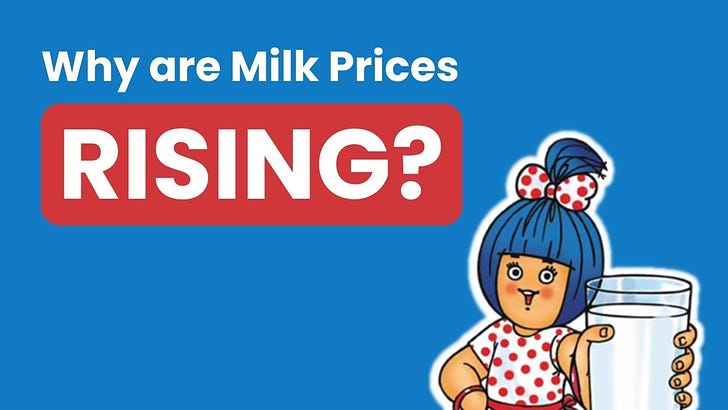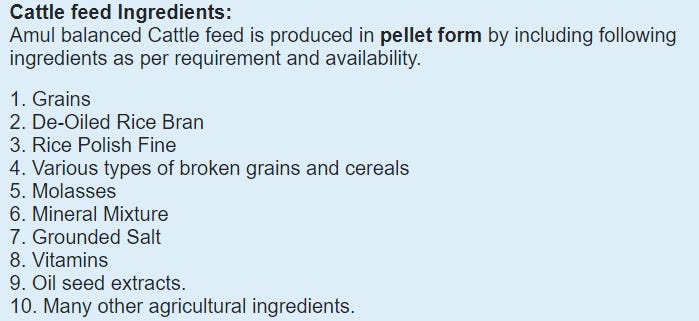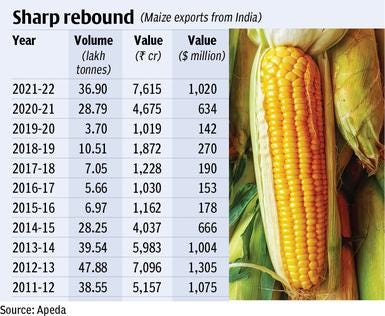🥛What’s Behind the Insane Rise in Milk Prices?
Milk prices are on the rise with more hikes coming our way. Here's what brought these prices to a boil.
Rs. 8/ litre.
That’s how much Amul has raised its milk prices in the last 12 months!
Milk prices, on average, have risen by Rs. 12/litre.
Result?
4 in 10 families have either reduced milk consumption or stopped buying milk.
This is the condition in a country where:
Milk has always been a staple ingredient in the Indian diet
70% of the population cannot afford a healthy diet
Per capita milk consumption exceeds the world average per capita consumption
Today we’re looking at three things:
Why are milk prices rising despite inflation cooling?
What can we do to reduce these prices?
Are there cheaper milk alternatives?
ReadOn!
🔍 The Root Cause Analysis
It all started in 2020, the year of the deadly pandemic..
During Covid, the demand for milk fell.
The tough times saw no weddings or celebrations, restaurants had shut down and tea stalls and ice-cream parlours had no customers.
And while the common man did consume more milk during this time, the increased consumption was not enough to compensate for the overall decline of milk consumption.
Supply exceeded demand. Prices of milk fell. Farmers got less income to feed cattle for the next season.
Result? Their cattle remained weak.
And this weak cattle is now producing less milk.
Then in 2022, the Lumpy Skin Disease struck.
It killed 1.5 Lakh cattle in India and decreased the productivity of those that survived!
Now, in 2023, the world has opened up and demand has recovered.
In case you haven’t checked Instagram, everyone is now getting married.
More marriages, more celebrations, more restaurants operating at full capacity calls for more milk.
This time, demand has exceeded supply (supply is down to 202.5 MMT in 2022 from 210 MMT in 2021).
Result? Milk prices are boiling.
But the low supply alone is not behind the boil in milk prices.
🧐 What Else is Causing the Insane Rise in Milk Prices
Another reason for rise in milk prices: high prices of cattle feed.
Cattle feed prices have increased by 15-20% in the last year!
Before we understand the reason behind this, let's understand a cow’s diet.
Most milk-producing cows are fed corn and oil cakes (residue left after oil is extracted from crops).
Now, corn prices have increased sharply in India because of:
rising exports
destruction of some crops due to bad weather.
Oil cakes are just low in supply.
You see, most livestock are fed oil cakes as they are super rich in protein.
While our livestock population has grown by 4.8% since 2012, oilseed production has grown only 1.9% (because growing other crops is more economically viable for farmers)!
Again: demand-supply mismatch.
Moreover, the rising prices of oil and natural gas have also made life difficult for the milk industry. This increase has, in turn, raised costs of:
Plastic packaging
Electricity
Transporting milk
And the worse part? This is supposed to be the flush season, when dairies have more milk than needed.
This milk is then used during the lean summer season when production falls.
So, more milk hikes could be ahead.
Enough with the problems. We’ve also put on our thinking caps to come up with some solutions.
🧠 Solution to the Milk Crisis
One of the ways to reduce milk prices would be to reduce the costs of production, i.e, the costs of cattle feed.
There are many other local plants like the mesquite tree that can be used to feed cattle.
Popularising these alternative cattle feed and subsidising them will require large-scale government intervention and farmer education.
This will take time.
Until then, we could import skimmed milk powder from European countries that have lower milk prices.
Plus, we need to find cheaper alternatives to milk, so that our country, and its people don’t face nutritional deficiency.
One option could be rice milk. Though store bought rice milk can be expensive (around Rs. 349/litre) , making rice-milk at home can be pocket-friendly.
Another cheap source of calcium is peanuts and sunflower seeds.
But, the common public needs to be educated about such affordable nutrition sources.
This needs the intervention of municipalities at a local level.
What else can be done to solve the problem?
Well, we’ve done our bit by researching and writing our article. You can do your bit by sharing this piece with your friends :)
Let us know if you found this informative? You can reply to this email with your responses or ping us directly on WhatsApp!




